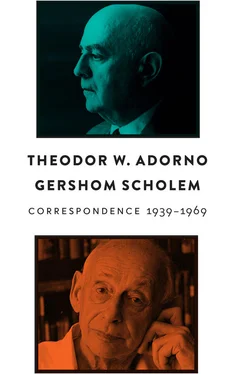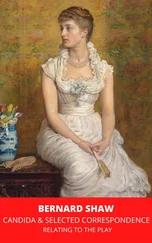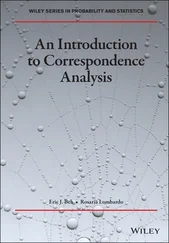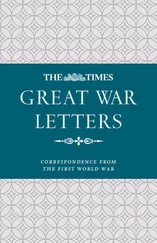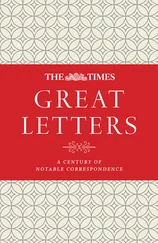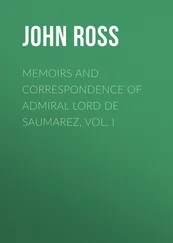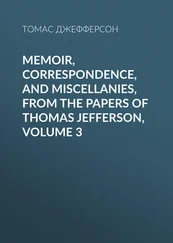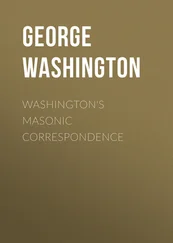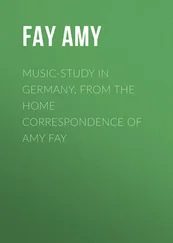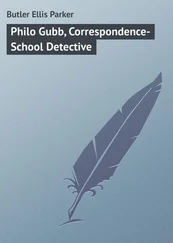Thematically, the correspondence begins with an in-depth textual analysis, namely, Adorno’s own interpretation of the Zohar, the Kabbalistic “Book of Splendor.” 31Adorno refers to Scholem’s own translation, which the two discussed during their first conversations in New York, a copy of which Scholem sent to Adorno after his return to Jerusalem. The chapter translated by Scholem is entitled “Sitrei Torah” [The secrets of the Torah]. It provides a mystical interpretation of the biblical story of the world’s creation in Genesis. 32Now it was Adorno’s turn to suggest his own interpretation – and this interpretation is not only illuminating in itself, it also provides a lens for understanding some of Adorno’s most central concepts. In his reading of Scholem’s translation, Adorno presents two substantial remarks: one concerns, as he writes, the history of philosophy, while the other concerns epistemology. Although the relation to Adorno’s own work is not conspicuous at first glance, a close examination will reveal the intrinsic relation between his reading of the text and his own work from the same time: the “philosophical fragments” that will comprise his seminal Dialectic of Enlightenment , co-authored with Horkheimer just a few years later. The proximity raises the question as to whether Adorno “ha[s] not read out of it anything other than what [he has] read into it,” as he is willing to admit, or whether these ideas found their way – directly or indirectly – into the reflections that constitute the Dialectic of Enlightenment ’s main theses.
Firstly, Adorno detects in the Zohar chapter a proximity between Jewish mysticism and the Neoplatonic gnostic tradition. He aligns the Zohar with the Western tradition of gnostic metaphysics, in which knowledge of the unknowable is sought in a negative way, through a search for the “remainders” of a presumed original experience, without presupposing such an experience. Adorno calls this a process of disintegration and emphasizes that, for him, the concept of disintegration carries no pejorative implications. On the contrary, understanding the process of disintegration is a most valuable method for a philosophy of history that seeks to detect historical truth by examining its demise. Although not explicitly stated in the letter, Benjamin’s theories of truth and allegory – as presented in Origin of the German Trauerspiel are most decisive here: both Adorno and Scholem were familiar with it (Adorno, in fact, held seminars on the book in the early 1930s in Frankfurt), and it arguably shaped their views on the concept of historical truth. For Adorno, such disintegration of experience and truth is the process that generates myth. When truth and experience can no longer be recognized or communicated in their immediacy, they tend to be translated into myth. These are the historical origins of myth and of mythical thinking. These are, at the same time, the very mystical truths and experiences that the Enlightenment sought to annihilate, but failed to do so, since it could revert back to myth only by creating ever newer mythologies. Adorno describes this process here as “the transformation of spiritualism into myth.” This, in a nutshell, is the argument that will be unfolded in the Dialectic of Enlightenment ’s diagnosis, namely that “Myth is already enlightenment, and enlightenment reverts to mythology.” 33
Secondly, Adorno asks about the nature of symbolic representation in Jewish mysticism – namely, whether the symbols conceal a hidden reality which can become tangible through a process of deciphering that would allow us to see reality as it is, or whether we can only face an endless chain of symbols: as he puts it, “whether there is any ground in this hierarchy of symbols or whether it represents a bottomless fall.” 34The latter case raises the question of what Adorno calls “the context of delusion” [ Verblendungszusammenhang ]. This concept, which will become ever more central and decisive in Adorno’s work, in the Dialectic of Enlightenment and in subsequent writings, is introduced here for the first time. It concerns the epistemological question as to the possibility of seeing beyond social and ideological delusion. If we are continuously being deceived by the mechanisms of power and domination, and if these mechanisms affect, first and foremost, our consciousness and our ability to see clearly and critically, then how is it possible to “see through the delusion”? This epistemological but, at the same time, social and political question is one of the most essential questions both in Adorno’s work and in the Frankfurt School’s critical theory overall. It is noteworthy that it is developed here, probably for the first time, by means of an interpretation of the Zohar.
It is fair to suggest that, while Adorno has never truly delved into the depths of Kabbalistic mysticism – or, for that matter, of any theological doctrine as such – he was indeed interested in its content and familiar with its ideas to the extent that he could reappropriate them for his own philosophical purposes. As noted above, having read Scholem’s Major Trends in Jewish Mysticism , Adorno acknowledged the significance and productive potential of Lurianic Kabbalah. Initially developed by Rabbi Isaac Luria (1534–1572) in the community of Safed, located in the Galilee region of Palestine, and further articulated by his disciples (Luria himself produced no written texts; his teachings were transcribed by his disciples), Lurianic Kabbalah is a mystical theory of redemption. It provides a cosmogonic theory of the world’s creation, as formed by an omnipotent God and shattered by His very omnipotence. Such shattering is deemed a crisis of destruction, which places the potential of mending and restitution in the hands of human beings. Metaphysical redemption depends, accordingly, on human agency. Luria calls it “ Tikkun ,” mending. Although it is impossible to assert with absolute evidence, there is good reason to consider Adorno’s final aphorism of Minima Moralia to be a response to such Lurianic metaphysics of shattering and restitution:
The only philosophy which can be responsibly practiced in face of despair is the attempt to contemplate all things as they would present themselves from the standpoint of redemption. Knowledge has no light but that shed on the world by redemption: all else is reconstruction, mere technique. Perspectives must be fashioned that displace and estrange the world, reveal it to be, with its rifts and crevices, as indigent and distorted as it will appear one day in the messianic light. 35
Beyond the use of theological, soteriological, and arguably Kabbalistic terminology, it seems that Adorno’s very argument on the scope of redemption provides a response – which requires human agency and action – to what he perceives as “damaged life”: the destruction of natural, individual life by late capitalism and its ideology. Viewed from this perspective, the subject of Adorno’s book of aphorisms largely resonates with the destruction of divine powers in the mystical story of the world’s creation in Luria’s Kabbalistic metaphysics. In both cases – and this point is crucial to Adorno as much as it is crucial for Luria – metaphysical, theological redemption depends on ethics: on human, moral action.
To what extent, however, and in what sense can one speak of messianism in Adorno’s philosophy? And how much of it is indeed indebted to Scholem’s scholarship? This is one of the central and most intriguing questions that emerge from their correspondence. There are numerous hints and indications in Adorno’s writings and throughout the correspondence, which call for various interpretations. But one version of messianism is decidedly pertinent in this context, namely that of heretical messianism. Before reading any of Scholem’s published texts, Adorno learned at first hand of Scholem’s research on the topic during their first conversations. Adorno had most likely not received a copy of Scholem’s German text on the topic from 1937 (a copy of which Scholem sent to Benjamin), but he had read the relevant chapters in Major Trends . He also kept track of Scholem’s papers for the Eranos conference, an annual meeting of scholars of religion, which took place in Ascona, Switzerland. Scholem participated regularly in these meetings and published his papers in the Eranos Yearbook . From the mid-1950s onward, Scholem’s main research papers were first presented at these conferences, and published in the Eranos Yearbook , before finding their way into his own published collections of articles. Adorno attested to collecting and reading these works, some of which – especially on the topic of messianism, as he wrote – meant a great deal to him personally. 36
Читать дальше
